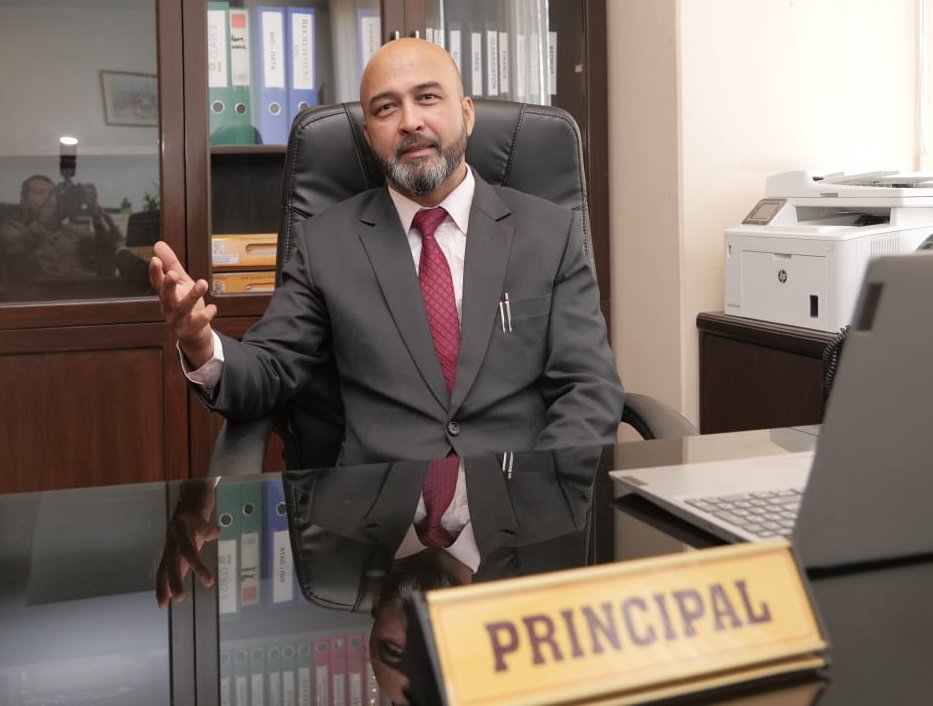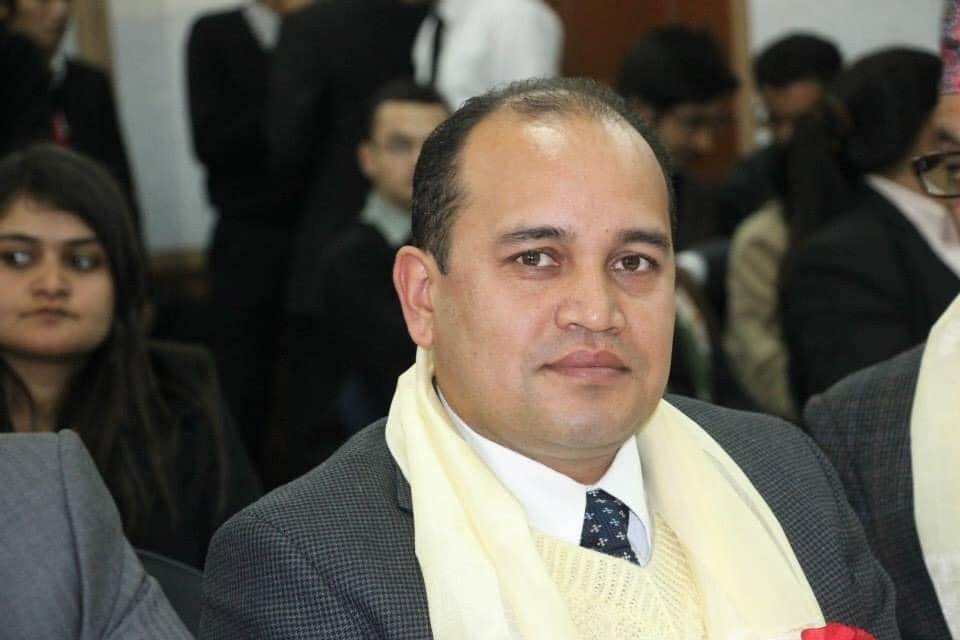Samriddhi School Spearheads Progressive Pedagogical Approach for Pragmatic Competency Enhancement

Amit Bikram Sijapati has been working in the education field for 16 years. He is a young and dynamic personality who was inspired to apply progressive learning when teaching. He used project-based learning to encourage students to learn more practically. He also had the opportunity to connect with the British Council as the School Ambassador. Mr. Sijapati currently works as the Principal at Samriddhi School. He concurrently works as a trainer at the British Council. He believes that teachers should first understand the psychological makeup of their students before they teach them. He understands that the transfer of education is a complex process because not every person pays attention. Mr. Sijapati spoke to College Readers to share his insights on teaching and learning approaches. Here are some excerpts from the conversation:
Could you explain Progressive learning in simple terms that the general public can understand?
In my view, the general populace perceives progressive learning as practical knowledge. Dr. Maria Montessori's philosophy forms the foundation of progressive learning, emphasizing individualized care for children with unique needs. In this approach, teachers must exhibit sensitivity towards students' learning processes, identifying comprehension gaps and reasons behind them. Observational skills are crucial. Teachers should encourage students positively and support them with student-led projects and plans.
Alongside Dr. Maria Montessori, Waldorf, rooted in Christian history, is a proponent of progressive learning. Further, the word progressive learning is coined by John Dewey who is considered a historical educational reformer. My interest in these approaches was sparked by Jiddu Krishnamurti's philosophy in "Flight of the Eagle," teaching acceptance of reality. The public views progressive learning as a blend of practical knowledge, technology, and extracurricular activities. It embodies an endless, evolving process, challenging the traditional American education system. John Dewey's advocacy for education beyond classroom confines reflects this movement. Following concepts like sustainable development and postmodernism, progressive education has gained attraction.
What are the aspects of progressive education?
Learning by doing is a simple way to understand the progressive method of education. It involves discussions, collaboration, presentation, feedback, and evaluation. The learning process should be connected with the community. Effective planning begins with teachers' teaching plans that align with the curriculum's objectives. Teachers should have an appropriate approach and focus on the actual aim of the lesson. It's important for teachers to recognize and understand the diversity among the students and be able to address them. Instead of lecturing, teachers should encourage discussions in the classroom. Assessments should determine students' understanding and their ability to express themselves. One way to evaluate students' understanding is to ask them to create questions about the topic. In the progressive method, students are encouraged to ask questions and engage with each other in the classroom.
What is the role of parental and community engagement in facilitating progressive learning?
Parents play an important role in the community, especially when it comes to schools. However, due to their busy schedules, they are not able to give time to their children. Those who give the time are willing to teach their children rather than listen to them. I do not see the rationality of parents teaching the children specifically for primary school students. This is because parents may not be familiar with the teaching methods used in schools and may end up confusing their children by using different techniques. Additionally, forcing children to learn can be counterproductive.
Instead, parents should focus on spending time with their children and instilling social values in them. One way to do this is by giving students time off on weekends so that they can spend quality time with their families. It is also important for students to learn about their community and the various institutions within it. Community organizations can help by organizing social programs in schools.
However, some parents may have unrealistic expectations when it comes to their children's academic performance. This can put undue pressure on students and hinder their ability to learn effectively. It is not possible for students to achieve top grades while also engaging in progressive learning. Therefore, it is important for parents to be realistic in their expectations and allow their children to learn at their own pace.
There are three categories of students: above average, average, and below average. Each student has unique abilities and potential. How can we provide individual care for them?
I have come to the realization that it is unfair to categorize students as academically weak or strong. I have witnessed individuals who were previously considered weak academically excel in their exams due to several reasons. Generally, students who perform well come from supportive environments where their parents actively involve themselves in their studies. In the context of progressive learning, it is important to identify and address the reasons behind a student's academic weakness. We should strive to understand each individual's potential and find ways of maximizing it. It is high time that we reevaluate the expectations of parents in this regard.
If the teachers applied 5E lesson planning in the school, would the progressive model succeed?
Progressive learning can be achieved through various methods. One such method is 5E, which stands for Engagement, Exploration, Explanation, Experience, and Evaluation.
The first step is the engagement strategy, where students are captured by generating their interest and encouraged to explore the topic. In the exploration phase, students are allowed to explore topics either through the web, books, or outside environments. Whatever techniques are used, the main point is students need to have questions. In this part, teachers need to facilitate to design right questions. The teacher explanation phase involves introducing relevant concepts, clarifying misconceptions, and providing additional information to support students' learning. In the elaboration phase, learners will relate the learning to the real-life context fundamentally to deepen the learning. Finally, the evaluation phase assesses students' learning and understanding of the topic through quizzes, presentations, or projects.
Another method is ABC, which stands for Anticipation, Building knowledge, and Consolidation. Anticipation involves generating curiosity among students, building knowledge is done by the teacher, and consolidation involves discussing the topic before evaluation.
The teaching way of teachers and mentors is crucial in the learning process.
How can schools effectively integrate skills, values, culture, and technology to enhance progressive learning?
I believe the three dimensions of knowledge, skills, and values are crucial. Knowledge has three different ontological perspectives, epistemological perspectives, and axiological perspectives. Ontology pertains to the nature of knowledge, epistemology explains how it functions, and axiology demonstrates its value. Knowledge must be acquired, and technologies must be utilized for its application. One illustration is Einstein's theory of relativity (E=mc2), which was misused to create atom bombs resulting in devastation. This misuse was a result of lacking values. "What I give to others, I will receive in return" embodies this core value.
Schools and colleges in Nepal are considering the idea of having counselors. What are your thoughts on their primary role?
The primary role of the counselors is to identify the emotional issues that children are going through and give mentoring support to bring them towards positivity. When discussing early adolescents, it is crucial to comprehend their physical and mental transformations. In such instances, counselors must lend an ear to mindfulness. Counselors are not meant to solve others' issues; rather, they should simply listen. It is advised that counselors refrain from offering direct solutions, as children may misinterpret them, leading to adverse effects. Schools’ ought to engage psychologists and incorporate positive psychology classes to uplift students. Prior consent from parents or the principal should be sought for individual counseling. This generation often exhibits attention-seeking tendencies. It is vital to distinguish between advice and suggestions. Advice typically stems from experienced individuals, while suggestions present possibilities.
What are your strategies to enhance progressive learning pedagogy at Samriddhi School as the principal?
Initially, I analyzed our teachers' communication strategy. In line with mindful leadership trends, it is crucial to grasp the mindset and place ourselves in that position to understand the underlying psychology. By being mindful of teachers, we can foster mindfulness among students, creating a positive cycle. I have introduced a non-violent communication approach for teachers and the board of directors, emphasizing the importance of creativity. I have recognized that individuals find happiness in creating something they are passionate about, highlighting the link between creativity and happiness. Furthermore, acknowledging and crediting the efforts of individuals is essential. Empowering students through roles like class monitors and captains ensures their engagement, allowing teachers to focus on academic progress while monitors handle classroom management.
What messages would you like to convey to parents and students?
I urge parents to be patient as we strive for a deeper understanding of our students. This endeavor requires time, so it is crucial to maintain hope and trust. I often refer to the concept of Learner's autonomy, emphasizing the freedom of students to learn. Our school utilizes a character card system where negative actions result in yellow cards, the accumulation of which leads to red cards. Conversely, positive behaviors earn blue cards, with 10/12 blues resulting in green cards. We reassure our students, "You are in a safe space; feel comfortable expressing yourself. Mistakes are natural, but effort is essential."





